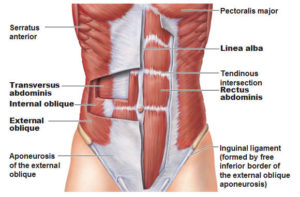The abdominal muscles are a group of muscles that form the abdominal wall. These muscles support your abdominal organs and spine. When the abdominal muscles contract they produce spinal movement so you can bend and twist, or hold the spine stable so you can stand upright. This is called ‘core stability’. The abdominal wall is divided into the anterolateral and posterior wall.
 There are five sets of anterolateral abdominal muscles. From superficial to deep, they are:
There are five sets of anterolateral abdominal muscles. From superficial to deep, they are:
- Rectus abdominis muscle – This muscle has the characteristic bumps or bulges that are commonly called ‘the six pack’.
- External abdominal oblique muscle – These are on each side of the rectus abdominis. The external oblique muscles allow the trunk to twist.
- Internal abdominal oblique muscle – These flank the rectus abdominis and are located just inside the hipbones.
- Transverse abdominis muscle – The deepest muscle layer. Its main roles are to stabilise the trunk and maintain internal abdominal pressure
- Pyramidalis muscle (present only in 80% of individuals)
The posterior abdominal wall consists of just three components:
- Quadratus lumborum muscle
- Iliopsoas muscles (composed of iliacus and psoas major muscles)
- Psoas minor muscle
The rest of the posterior abdominal wall is reinforced by the muscles of the back.
